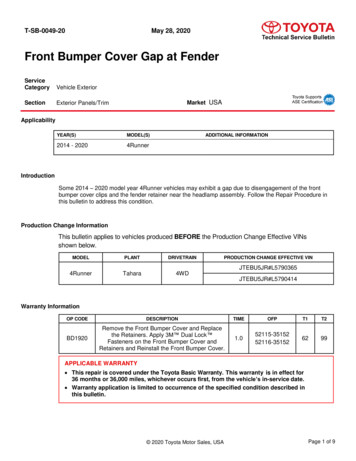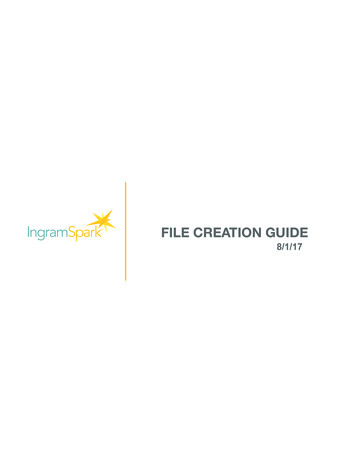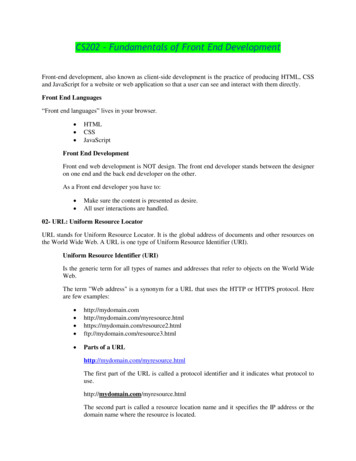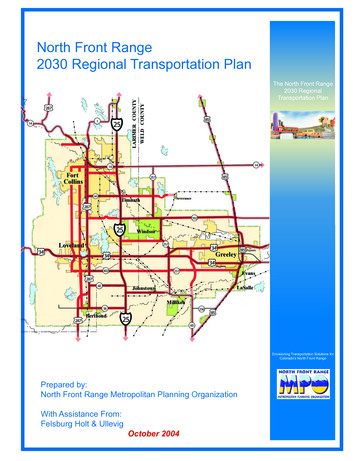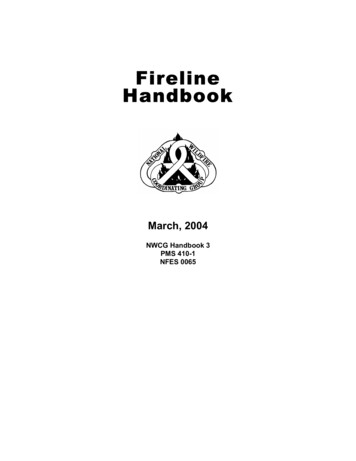
Transcription
IESPWorking Paper SeriesAccounting for Resource Use at the School-level and Below:The Missing Link in Education Administration and Policy MakingWORKING PAPER #09-06May 2009Dwight V. DenisonMartin SchoolUniversity of KentuckyLeanna StiefelWagner Graduate SchoolNew York UniversityWilliam HartmanCollege of EducationPennsylvania State UniversityMichele Moser DeeganMuhlenberg College
AcknowledgementsWe thank Thad Calabrese, Ross Rubenstein and participants at the 2008 AEFAconference for helpful comments on earlier drafts of the paper. Support for thiswork was provided by a grant from the Institute of Education Sciences, US Department of Education, Grant Number R305E050089. The authors retain responsibility for the content of the paper.Editorial BoardThe editorial board of the IESP working paper series is comprised of seniorresearch staff and affiliated faculty members from NYU's Steinhardt School ofCulture, Education, and Human Development and Robert F. Wagner School ofPublic Service. The following individuals currently serve on our Editorial Board:Amy Ellen SchwartzDirector, IESPNYU Steinhardt and NYU WagnerSean CorcoranNYU SteinhardtCynthia Miller-IdrissNYU SteinhardtLeslie Santee SiskinNYU SteinhardtLeanna StiefelAssociate Director for Education Finance, IESPNYU WagnerMitchell L. StevensNYU SteinhardtSharon L. WeinbergNYU SteinhardtBeth WeitzmanNYU Wagner
AbstractA long standing debate among policymakers as well as researchers is whether and howfunding affects the quality of education. Often missing from the discussion is information about the costs of providing education at the school level and below, yet suchinformation could impart a better indication of the linkages between outcomes andresources than is available with more macro-level data. In addition, because No ChildLeft Behind (NCLB) and state accountability systems often require reporting ofperformance at the grade or school level, micro-level cost information would be usefulto school administrators as they try to allocate resources productively.In this paper, we analyze the challenges involved in establishing a system to track costsat the school, grade, and subject level that will fit the needs of both internal and external users. To begin, we review the literature on cost accounting that is relevant tomicro-level costs and the research that analyzes sub-district level resources. Next, wedescribe general challenges that arise in reporting at the level of the school and belowand we then discuss school-level reporting in practice. We follow with a case study ofan improved reporting system that links resource use, student demographic characteristics, and student outcomes at the school, grade and subject level. We conclude withrecommendations for states when constructing such systems.
I. IntroductionA long standing debate among policymakers as well as researchers is whether andhow funding affects the quality of education. Often missing from the discussion isinformation about the costs of providing education at the school level and below, yet suchinformation could impart a better indication of the linkages between outcomes andresources than is available with more macro-level data. In addition, because No ChildLeft Behind (NCLB) and state accountability systems often require reporting ofperformance at the student, grade, or school level, micro-level cost information would beuseful to school administrators as they try to allocate resources productively. 1In order for cost information to be relevant to the decision making process, it hasto meet users’ needs, and in education there are several likely users, each with somewhatdifferent objectives. 2 When one asks about the school-level costs of education, it isimportant to ask: who wants to know and what are their objectives for knowing? Forpurposes of analysis in this paper, we separate users into two broad groups: externalusers, who include researchers and state and federal policy makers, and internal users,1Researchers have used micro-level student data from a few states for the purpose of studying andanalyzing education policies. For example, the Texas School Finance Project, the North Carolina EducationResearch Data Center, and the state of Florida have all facilitated numerous studies of their state’s schoolsand policies based on student data. Data on individual teachers are sometimes available as well, as in NewYork, Florida, and North Carolina. When students are linked to teachers and schools over years, the effectsof teachers, peers, and student mobility on student performance can be evaluated. (See Hanushek, Kainand Rivkin, 2004, on mobility; Clotfelter, Ladd and Vigdor, 2005, on teacher distributions; Sass, 2006, oncharter schools; Rockoff, Kane and Staiger, forthcoming, as well as Lankford, Loeb and Wyckoff, 2002,both on teacher performance) Yet, without detailed resource information at school, grade, and subjectlevel, the costs of policies and alternative input configurations cannot be accurately determined.2For example, economists, researchers and policy makers, for example, when deciding how to analyze theeconomic repercussions of a decision, are interested in marginal costs, replacement costs, total costs andopportunity costs. Auditors are interested in expenditures that are reported in the financial statements asdefined by generally accepted accounting principles, while local policy makers and school board memberswant to track budgets to insure that allocations are used as appropriated. Administrators, such assuperintendents and principals, desire to have a better understanding of costs in order to allocate resourcesmore efficiently and effectively.IESP Working Paper #09-061
who include administrators and school board members. 3 The information needed forinternal management purposes generally differs from the information needed to facilitateexternal accountability and evaluation research.More specifically, internal users who implement programs and run schools oreducational systems need to know about the costs under their control. Principals, forexample, must track resources at the school level in order to monitor the impact ofdecisions under their purview. External users, however, generally desire a system fortracking costs at the school level, even if they originate at the district or state level. Onthe surface it may appear easy enough to build a comprehensive system to the track costdata needed for both internal and external users. Yet, the task is more complicated than itfirst seems because accounting systems that are flexibly enough designed to meetdisparate objectives can easily become too cumbersome and expensive to operate.In this paper, we analyze the challenges involved in establishing a system to trackcosts at the school, grade, and subject level that will fit the needs of both internal andexternal users. To begin, we review the literature on cost accounting that is relevant tomicro-level costs and the research that analyzes sub-district level resources. Next, wedescribe general challenges that arise in reporting at the level of the school and below andwe then discuss school-level reporting in practice. We follow with a case study of animproved reporting system that links resource use, student demographic characteristics,and student outcomes at the school, grade and subject level. We conclude withrecommendations for states when constructing such systems.3These groupings are not meant to be definitive as some typically internal users (such as school boardmembers) might at times be considered external and visa versa.IESP Working Paper #09-062
This paper adds to our knowledge on sub-district fiscal reports by reviewing howsuch reports are currently used, presenting what kinds of data are now available and howthese data are constructed, and describing a cost-effective way to obtain an improved andintegrated fiscal and performance reporting system for both internal and external users atthe school, grade and subject level.II. Literature ReviewThe relevance to schools of management’s quest for cost informationOrganizations’ processes for collecting cost information generally focus on datarequired for financial reporting and budget allocations. Despite an abundance of accountand budget codes, these accounting systems often fail to package costs in a meaningful,user-friendly way for management decisions on such issues as how to improveproductivity or price products.In response, some firms implement a second cost tracking system. Since the mid1980s, activity-based costing has been especially popular and has been recommended foruse by public organizations (see Cooper and Kalpan, 1991). 4 Activity-based costingemploys cost drivers that target activities of production to assign overhead costs toproduced outputs. While there are many success stories about applications of activitybased costing, critics argue that activity-based costing involves too many allocations ofnon-direct/overhead costs and is expensive in terms of time and resources to implement(Armstrong 2002). Organizations less reliant on product pricing are generally perceivedto benefit less from detailed activity-based accounting systems (Estrin, Kantor, andAlbens 1994). Public organizations have had a particularly difficult time with their4The literature on ABC is voluminous. Cooper and Kalpan (1991) is a good place to start.IESP Working Paper #09-063
venture into activity-based costing, as documented by case studies at the federal and locallevels where such systems were judged to be modest successes at best (Brown et. al 1999;Martinson 2002, Mullens and Zorn 1999). 5Denison and Standora (2005) offer governments an alternative to activity-basedcosting that saves time and resources because it relies on micro data already generated bythe accounting system. 6 They suggest a process that classifies expenditure data intocontrollable and non-controllable costs. Controllable costs are those that result fromdecisions under the control of management, such as salaries and staff assignments. Noncontrollable costs arise from factors outside the management process, such as the rate ofinflation or unanticipated increases in clients served. For the terms “controllable” or“non-controllable” costs to be meaningful, a frame of reference must be determined, asall costs are controllable at some level. For school-level decision making in education,for example, a reasonable option would be to consider controllable costs as those under aprincipal’s responsibility.Researchers’ use of school-level cost dataSchool-level costs have been a topic of interest to school finance researchers forover a decade. For example, a number of authors have studied the equity of intra-districtdistributions in Ohio, California, Chicago, New York City, and a few other cities(Rubenstein, 1998; Moser, 1998; Peternick and Sherman 1998; Stiefel, Rubenstein andBerne, 1998; Goertz and Stiefel, 1998; Owens and Maiden, 1999; Betts, Rueben and5Contrary to the U. S. experience, however, Bjornenak (2000) applied activity-based costing methods toschools using data from the four largest cities in Norway. He concluded that “activity analysis providesdisaggregated data to better understand differences in the use of resources. Benchmarking the cost ofactivities in the public sector may be used both for performance measurement and to identify and adoptbetter ways to organize and execute activities.”6Non-profit organizations encounter many of the same issues around overhead allocation as dogovernments. See Hager, 2003 for an example involving allocation of fundraising expenditures.IESP Working Paper #09-064
Danneberg, 2000; Iatarola and Stiefel, 2003; Roza and Hill, 2003). Nakib (1996) usedsimilar school-level data in Florida to look at patterns of resource allocation acrossdistricts and time, finding that patterns by function were and remained remarkablysimilar. Summers and Wolfe (1976) and Schwartz and Stiefel (2003) used school-leveldata in Philadelphia and New York City, respectively, to assess the distribution ofresources by the racial, income or immigrant composition of schools. Finally, Stiefel,Schwartz, and Rubenstein (2005) measured the efficiency of schools in producingoutputs, such as test scores, based on New York City data. Most of these studies took thedata as given; data issues, when mentioned, tended to focus on the difficulty and cost ofcollection, accuracy, validity, comparability and usefulness (Picus, 2001).Several studies, however, have examined the relevance of school-level fiscal datasystems to decision makers and analysts. In a review of school-level financial data fromOhio and Texas, Sherman, Best and Luskin (1996) found that these systems provideddata for major functions (instruction, support services, non-instructional services) and forinstructional programs but did so primarily by allocating existing district-levelexpenditures downward. Issacs et al. (1997) looked at the Schools and Staffing Survey(SASS) to evaluate the opportunities and problems in collecting both staffing andexpenditure data at the school level and found that the main beneficiaries from usingSASS would be educational researchers and analysts, not administrators in schools andschool districts. Chambers (1999) compared two different approaches to measuringschool resources: the accounting approach (using expenditure data from existingeducational accounting systems) and the resource cost model (identifying resources inprograms—staff and non-personnel items—and placing prices, actual or standardized, onIESP Working Paper #09-065
these resources to determine the costs of the programs). He concluded that the resourcecost model provided more accurate and useful information for decision-making, althoughit required new data collection.Hartman, Bolton, and Monk (2001) undertook a synthesis of the accountingapproach and the resource cost model. They reviewed the elements of the data cycle forthree main groups of stakeholders—school and district administrators, researchers andpolicy analysts, and state and national policy makers—to examine their separate dataneeds and how they interacted with one another. In a synthesis of the two approaches, theaccounting approach was recommended to report and analyze expenditures at the schoollevel, while the resource cost model was proposed for comparative staffing analyses. Inboth cases, costs for centralized functions were recommended to remain at the districtlevel and not be allocated to schools. By contrast, Roza and Swartz (2007) developed amodel that allocates district expenditures (including traditionally labeled overheadexpenditures) to schools. These overhead expenditures appear to be assigned either byidentifying drivers such as special student populations or by digging into district recordsto see where personnel actually spend their time and effort.III. Challenges in Creating School, Grade, and Subject Fiscal, Performance andProductivity ReportsIn this section, we describe challenges encountered when constructing a system toprovide data at the school level and below. These challenges are categorized as“tractable” when they are relatively easy to address and “less tractable” when they aremore difficult. While the challenges generally apply to both the school and grade levels,IESP Working Paper #09-066
for brevity, the challenges are illustrated with examples from either the school or gradelevel.Relatively Tractable IssuesShared resources: Some resources, especially teachers in subjects such as art andmusic or reading specialists, are shared by schools. Generally, however, districts havetime or assignment records for these teachers so their salaries can be distributedaccurately, and with little extra effort, across buildings. A similar situation occurs whenteachers work with students in multiple grade levels.Non-professional staff: “Classified” or non-professional personnel that work inschools (e.g. aides, custodians, secretaries, food service staff) may work full-time or parttime and on a different schedule than the professional staff, and patterns vary acrossdistricts. Standardizing the non-professional personnel to full-time equivalents, based ona defined workweek and year (e.g. 40 hours per week, 36 weeks per year) is a way toaccount accurately for these personnel in a comparable manner across schools.Fringe benefits: Fringe benefits are generally recorded at the district level as apool, but applying a percentage proportional to salaries at schools will generally be agood enough approximation for school-level reporting, as long as school-level salariesare based on actual building salaries and not district averages.Inclusion of student outcomes: The benefit of fiscal reports is enhanced whenstudent outcomes are presented along with them. The advent of NCLB has made itconsiderably easier than in the past to obtain such data on test scores for grades 3 to 8 andone high school grade, but it is misleading to assume that a simple metric or productivitymeasure can completely capture school performance. It is particularly misleading whenIESP Working Paper #09-067
performance metrics are compared across dissimilar schools and districts. At aminimum, differences in student and community backgrounds are helpful to note.Furthermore, scholars have demonstrated methods for “value-added analysis” usingcohorts of students. The NCLB regulations now allow some states to utilize growthmodels for students’ progress and, with the use of some simple regression models, morenuanced measures can be developed.Less Tractable IssuesCapital Asset Expenditures: Capital assets by definition have useful lives overseveral “accounting periods” and generally over several years. This feature presents atleast two problems.First, some capital assets are paid from and charged to the operating budget, butare used for multiple purposes or grades. Even when the capital assets are clearlyassociated with a group of the students, it is still difficult to interpret them appropriatelyif purchases are made on a “take your turn” basis, but accounted for in one year. 7Second, depreciation expenses for capital assets are generally tracked at thedistrict level and are not reported with the budgetary expenses associated with a school.Maintenance expenses, however, often are tracked at the school level. Problems occursince older schools likely require more maintenance compared to new schools, while newschools have higher depreciation expenses, but these latter are not recorded as schoollevel charges.7More specifically, for example, a large expense associated with textbooks used exclusively by the fourthgraders may be used for several years. If paid for out of the current operating budget all of the expenseappears to go to the fourth grade for one year making fourth graders look expensive that year. In thefollowing year, the school may purchase textbooks for the fifth grade, making fifth graders appear moreexpensive per student and fourth graders looking substantially less costly compared to the preceding year.A similar situation occurs if a district funds capital improvements in the schools on a take your turn basis.IESP Working Paper #09-068
District-wide Expenditures: Some school fiscal reporting systems either allocateto schools all district-level expenditures that are not directly used by schools on a perpupil basis or, conversely, report these expenditures only at the district level and do notallocate them to schools. Examples of such expenditures are the office of thesuperintendent or the evaluation unit or the budget office, but others such astransportation, utilities, and food service are often treated in these ways as well. Forinternal users interested in analyzing school-level costs, the more relevant costs are thosefor which they are responsible and do not include district-wide expenditures. Forexternal users, however, including district-level costs in an analysis is important andrequires a standard method for allocating these costs. For external users, the functions leftat the district level need to be the same across districts, otherwise school reports will notbe comparable. Thus, a state that wants a dataset for all schools will need to be explicitabout how to handle each type of district-level expenditure.Special Services and Students: Uniformly tracking spending for specificprograms and students, such as special education, is particularly difficult because districtsemploy instructional programming policies that are treated differently in the accountingsystem and yield different cost reporting results.As encouraged by federal and state policymakers, many districts utilize integratedclassrooms, in which special education and regular education students are taught by thesame teacher(s). In these classrooms, the resources for special education are mingledwith the resources for regular education and cannot be separated easily. In addition, notall schools use the integrated approach to the same extent; most schools continue to havesome separate special education classes. If there were accessible records on the numbersIESP Working Paper #09-069
of students and classrooms that used each model in each school, percentages could beapplied to expenditures in order to separate the jointly-delivered services, but these kindsof statistics are not collected regularly.Additionally, some districts “contract out” with external organizations for theprovision of some of their special education services and these contracted-out servicescan be physically provided either in district facilities or outside the public schools. Thedistrict office does the contracting and generally does not account for the resultingexpenditures at the school level. In such circumstances, expenditures for schools thatprovide special education services in-house will be reported at the school level, whileexpenditures for the schools that contract the services will be reported at the district level.Even the district-level special education costs may not be comparable to an aggregationof in-house school-level special education costs since the contracted costs of specialeducation generally include the administrative and support costs of the provider, whichthen mixes instructional costs with non-instructional costs.Another factor that makes it difficult to assign special education costs to schoolsis that some the costs are intertwined with other functional expense classifications. Forexample, travel expenses for special education students can be significantly higher thanfor other students and yet all transportation costs are generally lumped together. Or thereare often higher maintenance expenses associated with facilities and equipment toprovide special education services, but these are not separately identified.Vocational education services, offered primarily at high schools, are anotherexample of some of these same issues – jointly offered classes and some contractingout—albeit at a lower overall level of total expenditure.IESP Working Paper #09-0610
Finally, data on the number of students served by special programs are not alwaysavailable at the school level, especially if the expenditures are partly or wholly accountedfor at the district level.IV. School-level Fiscal Reporting in PracticeThe complexities of generating fiscal data are illustrated through a recent (2000)Pennsylvania legislative initiative, Your Schools Your Money (YSYM). 8 Pennsylvaniais the seventh largest school system in the U.S., with 501 school districts and just over 1.8million students. YSYM was an ambitious attempt to collect school-, grade-, andsubject-level data by expanding the account codes for the various expenditure functionsdown to the school level. The initiative required all school districts to submit detailedsub-district level data to the Pennsylvania Department of Education (PDE). Morespecifically, at the school-level, YSYM required information to be reported for five broadgroups of operations: classroom instructional costs, instructional student support costs,facilities and maintenance costs, as well as grade level costs for elementary schools, andsubject matter costs for middle and high schools.During its development by the PDE, YSYM received extensive input from arange of school district practitioners and aspired to be the solution for school-level costdata. After only four years, however, the effort was suspended, in part because the newaccount codes required to track the cost detail at the school level ballooned well beyondanyone’s capacity for implementation (See Shrom and Hartman, 2008) 9 . As a result of8Act 16 of the Pennsylvania legislature, 2000.This ballooning of account codes is not unique to schools or even governments. In a recent article,Fernandez (2008) discusses the challenges of overwhelming account codes for larger firms desiring tosegment costs by programs and subsidiaries.9IESP Working Paper #09-0611
the massive accounting overload, many districts simply allocated total school levelexpenditures to the YSYM categories on an equal per-student basis. This severelycompromised the validity of the data and removed within-school variation in pupil costsacross grades or subject matter areas, which were primary objectives of YSYM.In addition to implementation concerns, YSYM experienced challenges to theusefulness of the data. For example, the individual school and district YSYM reportswere published electronically at the state level to provide parents and taxpayers withmore information about their local school system. The reporting format, however,presented the information for a single school site one year at a time, and without contextabout the school to assist in interpreting the results.Despite the challenges of producing school-level data, a few states havedeveloped cost systems to report these data. Two states, Florida and Ohio, have a longtradition of making available state-level fiscal data for all their public schools. 10 Table 1summarizes the criteria used by Ohio and Florida in addressing each of the challengesassociated with reporting school level data. Their approaches to dealing with the lesstractable issues differ in substantial ways from the Pennsylvania research-based approachthat is discussed later.Ohio addresses the tractable challenges primarily by using building level salariesas a cost driver. The Florida model also uses building level salaries for the sharedresources and fringe benefits. In Florida, non professional staff expenses that are notdirectly linked to a school (i.e., custodial staff, food service, general administration) areallocated to schools based on either the number of teachers in a program area, full-time10Texas also has available school-level data, although accessing it is considerably more difficult than inOhio or Florida.IESP Working Paper #09-0612
equivalent students, or time/space bases, which may vary by program. For example,allocations of food service and guidance staff are based on school enrollment whileallocations of staff for school maintenance are based on instructional time and spaceusage.Ohio and Florida deal similarly with capital assets -- maintenance expenses areassigned to the school level, but capital assets and debt service payments are notallocated. District-wide expenditures in both states are allocated back to the school levelusing an appropriate cost driver, such as staff full-time equivalents, program enrollment,or space/time usage. Both states use similar cost drivers to allocate costs for specialservices. The methods of Florida and Ohio might be summarized as an allocationapproach where the end objective is for all indirect costs (except for capital and debtservice expenses) to be allocated to the school level or below.IV. Case Study: School, Grade, and Subject Reporting in PennsylvaniaIn this section, we describe a case study of Pennsylvania school districts 11 tosuggest an improved and more relevant reporting system compared to the traditionalallocation method of producing school, grade and subject-level data. The research on thecase studies of four Pennsylvania school districts was managed by a team of fouracademic researchers (the authors of this paper) and five district business managers,advised by a board of three national finance experts, who worked together to constructuseful information for both internal and external decision makers. The school districtswere selected based upon their willingness to participate in the experiment and all hadskilled business office staff. The penultimate models were presented to district personnel,11The reporting system was also successfully applied in three districts in New York State.IESP Working Paper #09-0613
school business officers, and academics at a variety of professional and academicconferences and the final models incorporated the feedback from these forums.The research team developing the Pennsylvania case studies used the followingseven principles:1. Provide an expanded information and reporting system: The ultimate goals ofconstructing reports were to provide a tool that would allow internal users to make use ofresource information to improve student performance and that would be useful as well toexternal users. To this end, four separate types of data were deemed essential tojuxtapose (expenditures, personnel, student demographics, and student outcomes) so thatresources could be compared to student outcomes, the latter adjusted for studentcharacteristics that affect costs of education.2. Use the school site as unit of analysis: To be functional for internal users, thereports needed to focus on activities that administrators provide and mimic the way thatthose administrators make their decisions. Since in most school districts, principals areresponsible for budgets, operations and student results of individual schools, the schoolwas chosen as the unit of analysis. Fur
research staff and affiliated faculty members from NYU's Steinhardt School of Culture, Education, and Human Development and Robert F. Wagner School of Public Service. The following individuals currently serve on our Editorial Board: Amy Ellen Schwartz Director, IESP NYU Steinhardt and NYU Wagner Sean Corcoran NYU Steinhardt Cynthia Miller-Idriss
